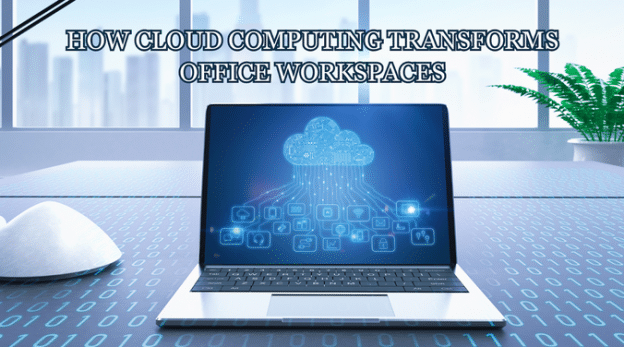Cloud computing can significantly enhance teamwork, productivity, and flexibility for businesses and professionals. As tech keeps getting better, it’s becoming super important for companies to jump on the cloud bandwagon if they want to stay ahead of the curve.
Some people worry about data security, regulatory compliance, and the complexity of transitioning to the cloud. This article is here to calm those fears and show you how the cloud can transform your workspace, making it easy to work with others, get stuff done fast, and work from anywhere.
What is Cloud Computing?Cloud computing is a paradigm shift in the way we store, access, and utilize data and applications. Instead of relying on physical hardware and software installed on individual computers, cloud computing leverages the power of the internet to provide on-demand access to a shared pool of computing resources, including storage, processing power, and software applications. |
The Benefits of Cloud Computing
The advantages of cloud computing are numerous and have paved the way for its widespread adoption across various industries:
- Scalability: Cloud services can be scaled up or down according to business needs, ensuring efficient resource utilization and cost optimization.
- Accessibility: With cloud computing, data and applications can be accessed from anywhere, at any time, using any internet-enabled device, fostering remote work and collaboration.
- Cost-effectiveness: By eliminating the need for expensive hardware and maintenance, cloud computing significantly reduces capital expenditure and operational costs for businesses.
- Automatic Updates: Cloud-based applications are regularly updated by the service providers, ensuring that users always have access to the latest features and security patches.
Transforming Office Workspaces
The adoption of cloud computing has had a profound impact on how office workspaces function, enabling new modes of collaboration, enhancing productivity, and promoting flexibility.
Cloud-based Collaboration and Communication
Cloud-based productivity suites have transformed collaboration within office environments. These platforms allow multiple users to work simultaneously on documents, spreadsheets, and presentations, fostering real-time collaboration and streamlining workflows.
Cloud-based communication and collaboration tools have transformed how teams interact and work together. These solutions enable instant messaging, video conferencing, screen sharing, and file sharing, facilitating seamless communication and collaboration, regardless of physical location.
Data Governance in the Cloud
To ensure effective data governance in the cloud, businesses should consider implementing the following practices:
- Data Classification and Labeling: Classify and label data based on sensitivity and criticality levels, enabling appropriate access controls and security measures.
- Access Management: Implement robust identity and access management controls, such as role-based access and multi-factor authentication, to ensure that only authorized personnel can access sensitive data.
- Data Lifecycle Management: Define and enforce policies for data retention, archiving, and disposal, ensuring compliance with regulatory requirements and minimizing data sprawl.
- Auditing and Monitoring: Implement auditing and monitoring mechanisms to track data access, modifications, and potential security incidents, facilitating timely incident response and compliance reporting.
Data Storage and Accessibility
The use of cloud storage solutions has done away with the need, for storage devices and local file servers. This advancement allows employees to easily access and share files from any location, ensuring that important data is always accessible and securely backed up. The emergence of cloud computing has made it possible for individuals to access office resources on the go enabling work flexibility. Through cloud-based applications and data accessibility on devices like smartphones and tablets, employees can remain productive. Connected even when they are not at their desks or in their offices.
Flexibility and Remote Work
Cloud-based platforms permit users to collaborate on documents, spreadsheets, and presentations promoting real-time cooperation and enhancing workflow efficiency. Communication and collaboration tools based on the cloud have revolutionized team interactions by offering features such as messaging, video conferencing, screen sharing, and file sharing. These tools facilitate communication among team members regardless of their locations.
Embracing the Cloud in Office Workspaces
To make the most of cloud computing advantages in office settings companies need to plan out and implement their cloud migration strategies.
Hybrid Cloud Approach
A hybrid cloud model combines infrastructure with public cloud services providing businesses with a transition to the cloud while retaining control, over sensitive data and essential applications.
Cloud-native Applications
Developing and deploying cloud-native applications can enable companies to leverage the benefits of cloud computing. These apps are tailored to make use of the scalability, durability, and flexibility provided by cloud platforms.
| Aspect | On-Premises | Cloud Computing |
| Infrastructure | Requires significant upfront investment in hardware and maintenance | Utilizes shared resources provided by cloud service providers, reducing capital expenditure |
| Scalability | Limited by physical infrastructure | Easily scalable according to business needs |
| Accessibility | Restricted to local network and physical location | Accessible from anywhere with an internet connection |
| Updates and Maintenance | Requires manual updates and maintenance by IT staff | Automatic updates and maintenance handled by cloud service providers |
| Collaboration | Limited to local network and VPN connections | Seamless collaboration through cloud-based tools and platforms |
| Disaster Recovery | Requires dedicated disaster recovery infrastructure and planning | Built-in redundancy and failover mechanisms provided by cloud service providers |
Data Protection and Compliance
As companies transition their data and software to cloud platforms ensuring data security and compliance, with industry regulations, becomes paramount. While cloud service providers offer security measures and certifications, businesses must enforce their own security policies.
Identity and Access Management
Establishing identity and access management controls is essential for the adoption of cloud services. Tools like sign-on (SSO) and multi-factor authentication (MFA) play a role in safeguarding sensitive data and limiting access to authorized personnel only.
Security in the Cloud
Robust Security Measures
Despite the advantages of cloud technology maintaining data security and privacy remains a priority for businesses. Cloud service providers have made investments in security measures to safeguard customer data and applications.
Encryption and Access Controls
To protect data during transmission and storage cloud providers utilize encryption protocols. Furthermore, they enforce access controls like factor authentication and role-based access management to ensure that only authorized individuals can access confidential information.
Compliance and Certifications
Major cloud service providers undergo rigorous security audits and obtain industry-specific certifications, such as SOC 2, HIPAA, and PCI DSS. These certifications ensure that the cloud providers adhere to strict security and compliance standards, providing businesses with the confidence to entrust their data and applications to the cloud.
Key Takeaways
- Maintaining data integrity is essential for businesses to make informed decisions, adhere to regulations, and uphold stakeholder confidence.
- Cloud security measures safeguard data from access, ensures its consistency and accuracy, protects it during transmission and enables backup and recovery processes.
- Implementing recommended practices such as access controls, encryption protocols, regular system updates, and staff training is crucial for preserving data integrity in the cloud environment.
- Data masking plays a role in safeguarding information promoting secure collaboration efforts ensuring compliance adherence and reducing risks associated with internal threats.
- Utilizing cloud security services offers functionalities, like monitoring capabilities and automated threat detection/response features that enhance the overall integrity of data.
Conclusion
Cloud computing has changed the game for office work. This technology has empowered businesses to not only survive but also flourish. It helps team members work together better, gets more work done, and makes work processes more flexible.
Plus, it tackles big concerns like keeping data safe and following rules, so businesses can operate securely and legally. As technology advances, it is increasingly important for companies to adopt cloud computing to maintain a competitive edge.
Frequently Asked Questions
How can I ensure compliance with industry regulations when using cloud services?
Lots of cloud companies have certifications for following the rules and sticking to standards. Businesses should check what rules they need to follow and pick cloud companies that meet those standards.
Can cloud computing solutions accommodate our legacy systems and applications?
Cloud providers offer hybrid solutions to integrate on-premises infrastructure with cloud services, making a gradual transition possible.
How can we ensure seamless collaboration when working remotely?
Online tools like video calls, shared screens, and project apps make it easy for people to chat and work together, no matter where they are.
What is the cost impact of migrating to the cloud?
So, you might have to spend some cash upfront to move to the cloud but it pays off in the long run. You won’t need to shell out for pricey hardware or maintenance, which can save you a pretty penny.


